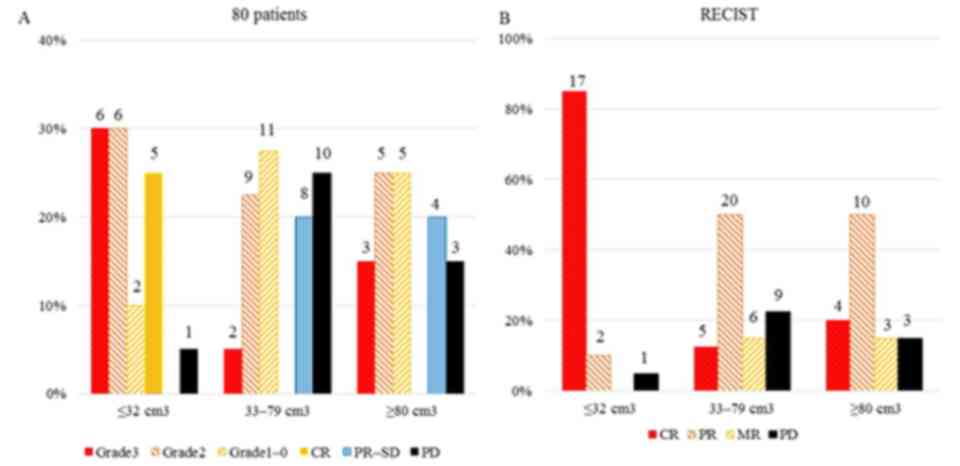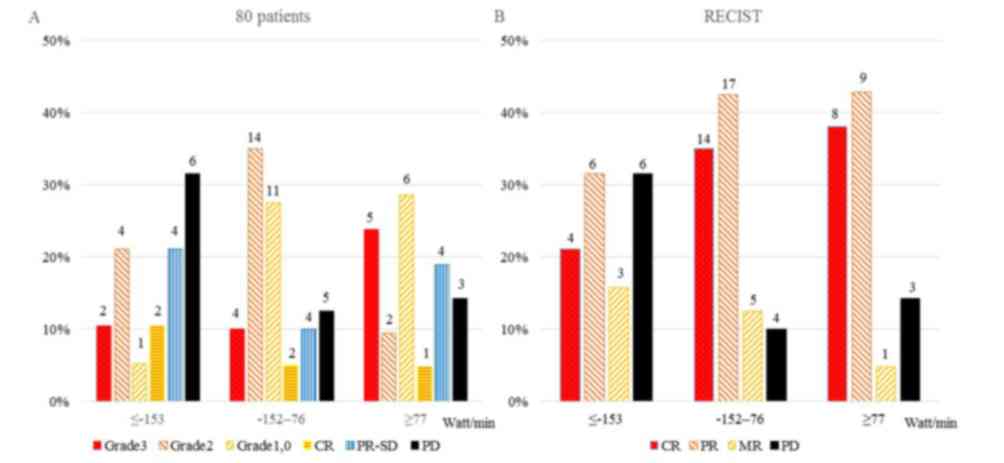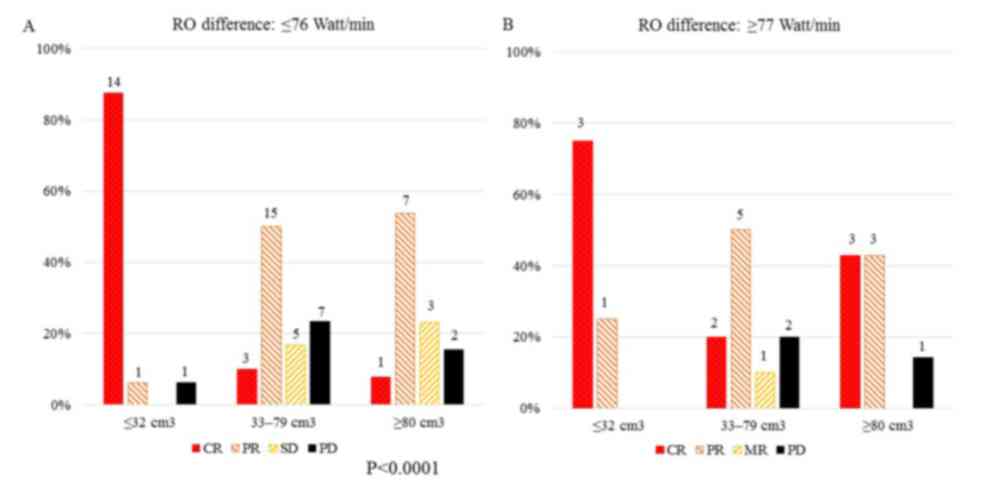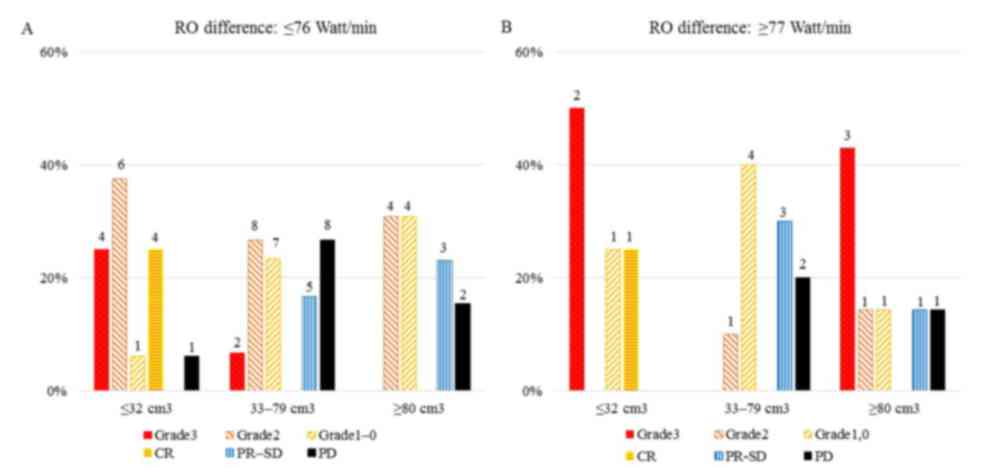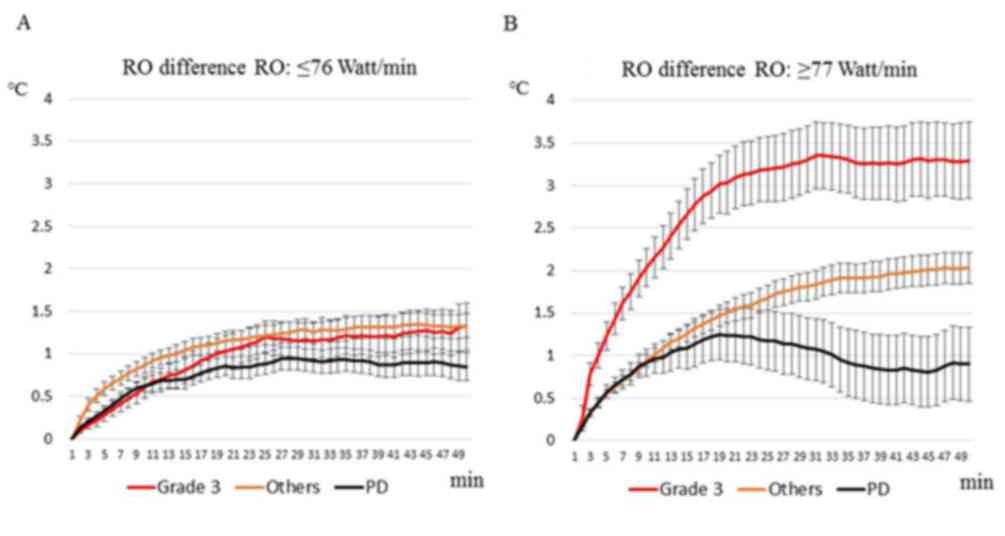Introduction
Neoadjuvant management philosophy depends on the
ability to predict the extent of pathological response using
clinical, imaging, and molecular parameters (1–3). Thus far,
no parameters have been validated in multi-institutional
prospective trials or used prior to starting treatment. New
pretreatment or posttreatment clinical, imaging, and molecular data
are required to monitor and predict treatment outcomes in
radiotherapy.
Neoadjuvant chemoradiation (NACR) for the treatment
of rectal cancer significantly increases the rate of pathological
complete response (pCR). Moreover, the local recurrence rate is
significantly lower among patients who received neoadjuvant
radiation, while there is no significant difference with respect to
disease-free survival or overall survival (4–8).
In contrast, there has been also reported that NACR
reduces the rate of local recurrence and improves local control,
which appears to result in improved overall survival (9–14).
Moreover, a certain subset of patients may not require surgery at
all according to the wait-and-see paradigm (15). On the basis of these favorable
results, NACR has been accepted as the standard therapy worldwide
except in Japan.
Meanwhile, radiofrequency (RF) hyperthermia using
the Thermotron-RF 8 has been administered mainly in Japan but
incurs a risk of the hotspot phenomenon, a potentially fatal
complication induced by RF treatment itself. To resolve this
problem, we established thermal therapy with standardized power
escalation principles, i.e., neothermia, and devised a predictive
formula for output-limiting symptoms (16,17) which
had an adjusted R2 of 0.99 and variance inflation factor
(VIF) values <2. This formula, is as follows: Initial energy
output at which an output limiting symptom occurred (Watt)=initial
time at which an output limiting symptom occurred (min) ×6.162-the
thickness of the fat of the abdominal wall (mm) ×17.155 +
967.995.
The present study aimed to evaluate whether NACR
response with concurrent thermal therapy for the treatment of
rectal cancer can be predicted after the first thermic treatment.
Because early assessment of treatment efficacy, and the decision on
continuation or cessation of cancer therapy are necessary for the
good quality life of the cancer patients.
Materials and methods
Between December 2011 and May 2015, 80 consecutive
patients with primary rectal adenocarcinoma localized in the rectum
(up to 12 cm from the anal verge) were included. All patients
received pre- and post-treatment diagnostic examinations including
CT, PET/CT, and MRI at Hidaka Hospital. The extent and location of
the tumors were classified according to the tumor-node-metastasis
staging (18). We classified the
location of the tumor by the results of MRI, CT and
colonoscopy.
All patients received NACR with concurrent thermal
therapy at Hidaka Hospital. Operations were performed at the
Department of General Surgical Science, Gunma University, or the
Division of Surgery, Hidaka Hospital. Each resected specimen was
evaluated histologically at the Department of Pathology, Gunma
University. This study was approved by the ethics committees of
Hidaka Hospital and Gunma University. Each patient gave written
informed consent. Tumor stages were defined on the basis of
colonoscopy, barium enema, CT, or 18F-fluorodeoxyglucose
PET/CT, and MRI.
The 80 patients were divided into quartiles with
respect to planning target volume (PTV), clinical target volume
(CTV), gross tumor volume (GTV), small intestine (n=63), and rectum
volume (n=67) as follows: PTV, ≤825, 826–945, 946–1,055, and ≥1,056
cm3; CTV, ≤624, 625–720, 721–841, and ≥842
cm3; GTV, ≤32, 33–50, 51–79, and ≥80 cm3;
small intestine volume, ≤265, 266–415, 416–694, and ≥695
cm3; rectum volume, ≤63, 64–80, 81–112, and ≥113
cm3. At present we think that it is difficult to
evaluate patients that would assure a statistically powerful and
unequivocal result. So we use the quartiles method to classify
tumors into 4 groups and finally found the correlation among GTV
≤32, 33–79, and ≥80 cm3 and RO difference RO difference:
≤76 Watt/min and RO difference: ≥77 Watt/min in this study.
Chemoradiotherapy
The GTV was contoured using the Focal Treatment
Planning system (Focal, Eindhoven, The Netherlands), taking into
consideration clinical information from imaging modalities to
identify the primary rectal tumor and enlarged regional lymph
nodes. The CTV included the GTV plus a 15-mm margin in the
anterior, posterior, and lateral directions and a 25-mm margin in
the craniocaudal direction in addition to the entire mesorectum and
internal iliac and presacral nodes. The cranial border was S2/3
interspace in order to reduce the irradiated small bowel volume. On
the basis of our institutional setup data, the PTV was determined
by adding a 3-mm margin around the CTV.
IMRT was administered conventionally, once daily, 5
times/week using TomoTherapy® (Hi-Art®
treatment system; ACCURAY®, Inc., Sunnyvale, CA, USA)
and neoadjuvant radiotherapy of 50 Gy delivered to the PTV in 25
fractions. The small intestines, bladder, and bilateral femur were
contoured and defined as organs at risk (OAR). The doses to OARs
were limited as follows: V98 <45 Gy for PTV, V15 <52.5 Gy for
PTV, and V10 <55 Gy for PTV. Capecitabine (Cap) was administered
orally at a dose of 1,700 mg/m2/day, 5 days per week
during the first to fifth weeks of NACR, beginning the day of the
start of radiation therapy and ending with the last dose of
radiation therapy.
Thermal therapy
Thermic treatment was administered using the
Thermotron-RF 8 (Yamamoto Vinita Co., Ltd., Osaka, Japan) once per
week for 5 weeks with 50 min irradiation. Precise methods of
thermal therapy were described elsewhere (16,17,19,20).
A sensor catheter with four temperature points was
attached to the skin on the lateral abdomen of 68 patients. The
average surface skin temperature of the four temperature points
during each irradiation was measured to calculate the average
surface skin temperature of the five thermal treatments.
Evaluation of treatment response and
adverse effect
Objective response was evaluated from week 2–18,
with a median of 8 weeks, and the timing of surgical resection
ranged from weeks 9–43, with a median of 16 weeks after the
completion of NACR with concurrent thermal therapy. Response was
evaluated according to the response evaluation criteria in solid
tumors using MRI, CT, or PET/CT (21). CR was defined as total disappearance
of the lesions and partial response (PR) was defined as a 30%
decrease in the sum of the diameters of the lesions until the
period of the evaluation. Stable disease (SD) was defined as
between a 30% decrease and 20% increase in the sum of the diameters
of the lesions. Finally, Progressive disease (PD) was defined as a
20% increase in the sum of diameters of the lesions or new distant
metastasis. We evaluated CR as the disappearance of the tumor on
PET/CT and MRI as well as a positive-to-negative change on
PET/CT.
Resected specimens were graded according to the
Japanese Classification of Colorectal Carcinoma as follows:
Pathological grade 0, no fibrosis in the specimen; grade 1a,
denaturation and necrosis of cancer cells in approximately <1/3
of the cancer; grade 1b, denaturation and necrosis in <2/3 of
cancer cells plus fusion in >1/3 of the cancer; grade 2,
significant denaturation, necrosis, fusion, and loss in >2/3 of
the cancer; grade 3 (i.e., pCR), no cancer cells observed in both
primary and regional lymph nodes (18). Adverse effects were evaluated on the
basis of the Common Terminology Criteria for Adverse Events (4.0)
(22).
Statistical analysis
SPSS v21 (IBM Corp., Armonk, NY, USA) was used for
all statistical analyses. Mean values were compared using paired
Students t-test and ANOVA with Tukey-Kramer HSD (honestly
significant difference) test for multiple comparisons. Categorical
data were analyzed using the χ2 test. All reported
P-values are two-tailed and P<0.05 was considered to indicate a
statistically significant difference..
In the present study, by using the predictive
formula for output-limiting symptoms mentioned above, we used an
initial time of 0 min for the time at which an output limiting
symptom occurred as a predicted initial RF output (IRO (Watt)), and
compared it to the actual observed RF output (i.e. RO difference
(Watt/min)=average actual observed RO (Watt/min) during 50 mins RF
irradiation-predicted IRO). For RO differences, the quartiles were
≤-153, −152 to −77, −76 to 76, and ≥77 Watt/min at the first
thermal treatment.
Results
Patients characteristics
Among the 80 patients, 26 (32.5%), 32 (40%), 9
(11.3%), and 13 (16.3%) achieved CR, PR, SD, and PD, respectively.
Consequently, 11 (13.8%), 20 (25%), 18 (22.5%), 5 (6.3%), 12 (15%),
and 14 (17.5%) patients were pCR (i.e., grade 3), grade 2, grade
1-0, CR, PR-SD in no resection, and PD included 4 resections,
respectively. Reduced tumor burdens were observed in 37/53 (69.8%)
patients. In the therapeutic response, there was no significant
difference between macroscopic types such as polypoid or ulcerative
tumors. Because polypoid tumors were small number.
Table I shows patients
characteristics according to the RO differences. There were
significant differences in body mass index and internal organs fat
area between patients with the RO difference ≤76 Watt/min and ≥77
Watt/min.
 | Table I.Characteristics of 80 patients
according to the RO differences. |
Table I.
Characteristics of 80 patients
according to the RO differences.
|
| Difference RO |
|
|
|---|
|
|
|
|
|
|---|
|
Characteristics | ≤76 Watt/min | ≥77 Watt/min | Total | P-value |
|---|
| Total no. of
patients | 59 | 21 | 80 |
|
| Age, years |
|
|
| 0.301 |
|
Median | 62 | 65 | 63 |
|
|
Range | 33–89 | 42–89 | 33–89 |
|
| Sex, no. (%) |
|
|
| 0.056 |
|
Female | 18 (30.5) | 2 (9.5) | 20 |
|
|
Male | 41 (69.5) | 19 (90.5) | 60 |
|
| Distance to anal
verge, no. (%) |
|
|
| 0.700 |
| 0–3.0
cm | 41 (69.5) | 13 (24.1) | 54 |
|
| 3.1–5.0
cm | 11 (18.6) | 4 (26.7) | 15 |
|
| ≥5.1
cm | 7 (11.9) | 4 (36.4) | 11 |
|
| Tumor location, no.
(%) |
|
|
| 0.457 |
| Ra | 6 (10.2) | 4 (19.0) | 10 |
|
| Rb | 33 (55.9) | 10 (47.6) | 43 |
|
|
RbP | 20 (33.9) | 7 (33.4) | 27 |
|
| Tumor stage, no.
(%) |
|
|
| 0.284 |
| T2 | 14 (23.7) | 6 (28.6) | 20 |
|
| T3 | 36 (61.0) | 9 (42.9) | 45 |
|
| T4 | 9 (15.3) | 6 (28.6) | 15 |
|
| Lymph node stage,
no. (%) |
|
|
| 0.691 |
| N0 | 31 (52.5) | 9 (42.9) | 40 |
|
| N1 | 26 (44.1) | 11 (52.4) | 37 |
|
| N2 | 1 (1.7) | 1 (4.8) | 2 |
|
| N3 | 1 (1.7) | 0 (0.0) | 1 |
|
| Distant metastasis,
no. (%) |
|
|
| 0.451 |
| M
(−) | 53 (89.8) | 20 (95.2) | 73 |
|
| M
(+) | 6 (10.2) | 1 (4.8) | 7 |
|
| Pretreatment TNM
stage, no. (%) |
|
|
| 0.700 |
| Stage
1 | 8 (13.6) | 4 (19.0) | 12 |
|
| Stage
2 | 19 (32.2) | 5 (23.8) | 24 |
|
| Stage
3 | 26 (44.1) | 11 (52.4) | 37 |
|
| Stage
4 | 6 (10.2) | 1 (4.8) | 7 |
|
| Tumor
differentiation, no. (%) |
|
|
| 0.157 |
| Well
differentiated | 26 (44.1) | 11 (52.4) | 37 |
|
|
Moderately differentiated | 27 (45.8) | 9 (42.9) | 36 |
|
| Poorly
differentiated | 6 (10.2) | 0 (0.0) | 6 |
|
|
Undifferentiated | 0 (0.0) | 1 (4.8) | 1 |
|
| Type of surgery,
no. (%) |
|
|
| 0.985 |
|
APR | 9 (15.3) | 3 (14.3) | 12 |
|
|
LAR | 10 (16.9) | 3 (14.3) | 13 |
|
|
sLAR | 11 (18.6) | 4 (19.0) | 15 |
|
|
ISR | 5 (8.5) | 2 (9.5) | 7 |
|
| Local
incision | 5 (8.5) | 1 (4.8) | 6 |
|
| No
resection | 1 (1.7) | 1 (4.8) | 2 |
|
| No
surgery | 18 (30.5) | 7 (33.3) | 25 |
|
| BMI, SD | 23.6, 3.2 | 21.3, 3 |
| 0.001 |
| Internal organs fat
area (cm2), SD | 103.1, 55.8 | 72.9, 50.4 |
| 0.013 |
Treatment response according to the
GTVs
Fig. 1 shows the
results of treatment response according to the GTVs (≤32
cm3, 33–79 cm3, and ≥80 cm3) among
80 patients (A) and RECIST criteria (B). The highest CR and pCR
were shown 85.0 and 30%, respectively, in patients with a GTV ≤32
cm3. There were significant differences in treatment
responses among GTVs in (A) and (B) (χ2=30.423, P=0.001
and χ2=34.385, P<0.0001, respectively).
Treatment response according to the RO
differences
Fig. 2 shows the
results of treatment response according to the RO differences
(≤-153 Watt/min, −152-76 Watt/min, and ≥77 Watt/min among 80
patients (A) and RECIST criteria (B). The highest CR and pCR were
shown 38.1 and 23.8%, respectively, in patients with a RO
difference ≥77 Watt/min. There was no significant difference in
treatment responses among RO differences in (A) and (B).
Treatment response of according to the
RO difference
Figs. 3 and 4 shows the results of treatment response of
RECIST criteria (Fig. 3) and 80
patients (Fig. 4) according to the RO
difference (≤76 Watt/min (A) vs. ≥77 Watt/min (B)) and GTV (≤32
cm3, 33–79 cm3, ≥80 cm3). The
highest rates of CR (87.5%) were observed in patients with a GTV
≤32 cm3 and a RO difference ≤76 Watt/min (Fig. 3), while a RO difference ≥77 Watt/min
group showed higher rates of pCR in those with a GTV ≤32
cm3 or ≥80 cm3 (50.0% or 42.9%, respectively)
than the RO difference ≤76 Watt/min group (Fig. 4). There was a significant difference
in treatment responses among GTVs in RECIST criteria patients with
a RO difference ≤76 Watt/min group (Fig.
3A) (χ2=34.526, P<0.0001) and not in those with a
RO difference ≥77 Watt/min group (Fig.
3B). There was also a significant difference in treatment
responses among GTVs in 80 patients with a RO difference ≤76
Watt/min group (Fig. 4A)
(χ2=24.365, P=0.007) and not in those with a RO
difference ≥77 Watt/min group (Fig.
4B).
Changes of the surface skin
temperature
Changes of the surface skin temperature during the
50 min of irradiation are shown in Fig.
5. Skin temperature significantly changed in patients with a
pathological grade 3 tumor compared both to those who had PD and
other outcomes, only in the RO difference ≥77 Watt/min group
(Tukey-Kramer HSD test, P<0.001). In the RO difference ≤76
Watt/min group there was no significant difference among patients
with grade 3, other outcomes and PD.
Toxicity
NACR with concurrent thermal therapy was tolerated
well, with 96.3% of patients receiving the full dose of
chemotherapy and 100% receiving the full dose of radiotherapy with
5 sessions of thermal therapy. Grade 3 toxicity was observed in
7/80 (8.8%) patients. Six of them were classified as
non-hematologic toxicity. The remaining one patient had hematologic
toxicity as anemia. There was no significant difference between
hematologic and non-hematologic toxicity.
During thermic treatment, 72 (90%) patients
experienced at least one instance of a troublesome hotspot
phenomenon such as pain/irritable sensations (85%) and subcutaneous
induration (6.3%).
Discussion
The positive outcome of IMRT plus Cap has been
demonstrated by pCR rates ranging from 14.1–30.6%, with grade 3
toxicity rates from 11.1–17.6% (6,8,23–27). These
results suggest IMRT has the potential for higher tumor control
rates and/or less toxicity for patients. Nevertheless, more
accurate and precise delineation of the target is required.
Recentry, Valentini et al (28) recommended PTV used is 10–15 mm in view
of rectal motion.
In trials of preoperative helical tomotherapy for
rectal cancer, De Ridder et al (29) reported that the metabolic response
rate was 45% in the non-boosted group compared with 77% in the
boosted group. Huang et al (30) reported that there was no significant
differences between patients who received tomotherapy or other
therapy with respect to pCR (14.3% vs. 8.8%), T downstaging (60%
vs. 61.4%), N downstaging in patients with cN1-2 (69.6% vs. 79.1%),
ypT0-2N0 (57.1% vs. 43.9%), or sphincter preservation rate for
low-lying rectal cancer (85.2% vs. 80.0%). Four patients in the
tomotherapy group (11.1%) and 10 in the other therapy group (16.7%)
developed G3 acute toxicities during CRT.
From the viewpoint of hyperthermia, Maluta et
al (31) reported that
hyperthermia plus chemoradiation resulted in 23.6% patients
achieving pCR and 5.2% patients with PD. Schroeder et al
(32) retrospectively compared
neoadjuvant radiation with concurrent 5-FU-based chemotherapy with
and without hyperthermia in 106 rectal cancer patients; pCR was
achieved by 6.7 and 16.4% of patients, respectively. The rate of
sphincter-sparing surgery was 57% in the hyperthermal
radiochemotherapy group compared with 35% in the radiochemotherapy
group.
Among the nonrandomized and randomized studies
mentioned above, none describe the associations of outcomes among
dosimetric parameters such as physical volumes of TVs of tumors or
the associations between physical volumes of TVs and patient
outcomes.
Although our idea based on the results of NACR with
concurrent thermal therapy is novel, one possible explanation is
that both radiation and RF treatment have electromagnetic effects
owing to low-energy, low-frequency (8 MHz) waves and high-energy,
high-frequency (>3×1019 Hz) waves on cancer cells,
respectively. This results in concurrent RF treatment appearing to
have a potential filter effect on the results of radiation
treatment, because outputable/heatable conditions may be associated
with good response to chemoradiation (20).
The present study has some limitations. First, the
small sample size meant there was no comparison group that received
radiotherapy with concurrent Cap. Second, the post-treatment
follow-up duration was short. Therefore, further studies should be
performed to confirm these results.
The results show that the associations between
parameters of TVs, patients state and change of body temperature
are good predictors of outcomes in patients with rectal cancer who
receive NACR with concurrent thermal therapy. First, GTV ≤32
cm3 patients are indicated for this NACR with or without
concurrent thermic treatment and second, large tumor patients (GTV
≥80 cm3) need to treat this NACR with concurrent thermic
treatment. And also our idea might be able to use for early
assessment of treatment efficacy, and will help the decision of the
continuation or cessation of this treatment modality.
Acknowledgements
Not applicable.
Funding
No funding was received.
Availability of data and materials
The datasets used and/or analyzed during the current
study are available from the corresponding author on reasonable
request.
Authors contributions
HS contributed significantly to writing of the
manuscript and analysis of clinical data. MM, KO, AT, HK and TT
contributed to the design and implementation of the research, and
to the analysis of the results. KO contributed to the conception of
the study and performed statistical analysis. All authors read and
approved the final manuscript.
Ethics approval and consent to
participate
The Ethics Committee for Human Studies at Hidaka
Hospital (Takasaki, Gunma, Japan) approved the present study, which
was conducted in accordance with The Declaration of Helsinki.
Participants were fully informed of the procedures, and written
informed consent was obtained from all patients.
Consent for publication
Not applicable.
Competing interests
The authors declare that they have no competing
interests.
References
|
1
|
Powathil GG, Adamson DJ and Chaplain MA:
Towards predicting the response of a solid tumour to chemotherapy
and radiotherapy treatments: clinical insights from a computational
model. PLoS Comput Biol. 9:e10031202013. View Article : Google Scholar : PubMed/NCBI
|
|
2
|
Holck S, Nielsen HJ, Pedersen N and
Larsson LI: Phospho-ERK1/2 levels in cancer cell nuclei predict
responsiveness to radiochemotherapy of rectal adenocarcinoma.
Oncotarget. 6:34321–34328. 2015. View Article : Google Scholar : PubMed/NCBI
|
|
3
|
Guo Z, Shu Y, Zhou H, Zhang W and Wang H:
Radiogenomics helps to achieve personalized therapy by evaluating
patient responses to radiation treatment. Carcinogenesis.
36:307–317. 2015. View Article : Google Scholar : PubMed/NCBI
|
|
4
|
Bosset JF, Calais G, Mineur L, Maingon P,
Stojanovic-Rundic S, Bensadoun RJ, Bardet E, Beny A, Ollier JC,
Bolla M, et al: Fluorouracil-based adjuvant chemotherapy after
preoperative chemoradiotherapy in rectal cancer: Long-term results
of the EORTC 22921 randomised study. Lancet Oncol. 15:184–190.
2014. View Article : Google Scholar : PubMed/NCBI
|
|
5
|
Sauer R, Liersch T, Merkel S, Fietkau R,
Hohenberger W, Hess C, Becker H, Raab HR, Villanueva MT, Witzigmann
H, et al: Preoperative versus postoperative chemoradiotherapy for
locally advanced rectal cancer: Results of the German
CAO/ARO/AIO-94 randomized phase III trial after a median follow-up
of 11 years. J Clin Oncol. 30:1926–1933. 2012. View Article : Google Scholar : PubMed/NCBI
|
|
6
|
Park JH, Yoon SM, Yu CS, Kim JH, Kim TW
and Kim JC: Randomized phase 3 trial comparing preoperative and
postoperative chemoradiotherapy with capecitabine for locally
advanced rectal cancer. Cancer. 117:3703–3712. 2011. View Article : Google Scholar : PubMed/NCBI
|
|
7
|
Peeters KC, Marijnen CA, Nagtegaal ID,
Kranenbarg EK, Putter H, Wiggers T, Rutten H, Pahlman L, Glimelius
B, Leer JW, et al: The TME trial after a median follow-up of 6
years: Increased local control but no survival benefit in
irradiated patients with resectable rectal carcinoma. Ann Surg.
246:693–701. 2007. View Article : Google Scholar : PubMed/NCBI
|
|
8
|
Das P, Lin EH, Bhatia S, Skibber JM,
Rodriguez-Bigas MA, Feig BW, Chang GJ, Hoff PM, Eng C, Wolff RA, et
al: Preoperative chemoradiotherapy with capecitabine versus
protracted infusion 5-fluorouracil for rectal cancer: A matched
pair analysis. Int J Radiat Oncol Biol Phys. 66:1378–1383. 2006.
View Article : Google Scholar : PubMed/NCBI
|
|
9
|
Maas M, Nelemans PJ, Valentini V, Das P,
Rödel C, Kuo LJ, Calvo FA, García-Aguilar J, Glynne-Jones R,
Haustermans K, et al: Long-term outcome in patients with a
pathological complete response after chemoradiation for rectal
cancer: A pooled analysis of individual patient data. Lancet Oncol.
11:835–844. 2010. View Article : Google Scholar : PubMed/NCBI
|
|
10
|
Yeo SG, Kim DY, Kim TH, Chang HJ, Oh JH,
Park W, Choi DH, Nam H, Kim JS, Cho MJ, et al: Pathologic complete
response of primary tumor following preoperative chemoradiotherapy
for locally advanced rectal cancer: Long-term outcomes and
prognostic significance of pathologic nodal status (KROG 09–01).
Ann Surg. 252:998–1004. 2010. View Article : Google Scholar : PubMed/NCBI
|
|
11
|
Park IJ, You YN, Agarwal A, Skibber JM,
Rodriguez-Bigas MA, Eng C, Feig BW, Das P, Krishnan S, Crane CH, et
al: Neoadjuvant treatment response as an early response indicator
for patients with rectal cancer. J Clin Oncol. 30:1770–1776. 2012.
View Article : Google Scholar : PubMed/NCBI
|
|
12
|
Fokas E, Liersch T, Fietkau R, Hohenberger
W, Beissbarth T, Hess C, Becker H, Ghadimi M, Mrak K, Merkel S, et
al: Tumor regression grading after preoperative chemoradiotherapy
for locally advanced rectal carcinoma revisited: Updated results of
the CAO/ARO/AIO-94 trial. J Clin Oncol. 32:1554–1562. 2014.
View Article : Google Scholar : PubMed/NCBI
|
|
13
|
Zhu J, Gu W, Lian P, Sheng W, Cai G, Shi
D, Cai S and Zhang Z: A phase II trial of neoadjuvant IMRT-based
chemoradiotherapy followed by one cycle of capecitabine for stage
II/III rectal adenocarcinoma. Radiat Oncol. 8:1302013. View Article : Google Scholar : PubMed/NCBI
|
|
14
|
Roh MS, Colangelo LH, OConnell MJ, Yothers
G, Deutsch M, Allegra CJ, Kahlenberg MS, Baez-Diaz L, Ursiny CS,
Petrelli NJ and Wolmark N: Preoperative multimodality therapy
improves disease-free survival in patients with carcinoma of the
rectum: NSABP R-03. J Clin Oncol. 27:5124–5130. 2009. View Article : Google Scholar : PubMed/NCBI
|
|
15
|
Habr-Gama A, Perez RO, Nadalin W, Sabbaga
J, Ribeiro U Jr, Silva e Sousa AH Jr, Campos FG, Kiss DR and
Gama-Rodrigues J: Operative versus nonoperative treatment for stage
0 distal rectal cancer following chemoradiation therapy: Long-term
results. Ann Surg. 240:711–718. 2004.PubMed/NCBI
|
|
16
|
Shoji H, Motegi M, Osawa K, Okonogi N,
Okazaki A, Andou Y, Asao T, Kuwano H, Takahashi T and Ogoshi K:
Does standardization of radiofrequency hyperthermia benefit
patients with malignancies? Ann Cancer Res Ther. 22:28–35. 2014.
View Article : Google Scholar
|
|
17
|
Shoji H, Motegi M, Osawa K, Okonogi N,
Okazaki A, Andou Y, Asao T, Kuwano H, Takahashi T and Ogoshi K:
Output-limiting symptoms induced by radiofrequency hyperthermia.
Are they predictable? Int J Hyperthermia. 32:199–203. 2016.
View Article : Google Scholar : PubMed/NCBI
|
|
18
|
Japanese Society for Cancer of the Colon
and Rectum: Japanese classification of colon carcinoma. 8th
edition. Kanehara, Tokyo: 2013
|
|
19
|
Shoji H, Motegi M, Osawa K, Okonogi N,
Okazaki A, Andou Y, Asao T, Kuwano H, Takahashi T and Ogoshi K: A
novel strategy of radiofrequency hyperthermia (neothermia) in
combination with preoperative chemoradiotherapy for the treatment
of advanced rectal cancer: A pilot study. Cancer Med. 4:834–843.
2015. View
Article : Google Scholar : PubMed/NCBI
|
|
20
|
Shoji H, Motegi M, Osawa K, Okonogi N,
Okazaki A, Andou Y, Asao T, Kuwano H, Takahashi T and Ogoshi K:
Radiofrequency thermal treatment with chemoradiotherapy for
advanced rectal cancer. Oncol Rep. 35:2569–2575. 2016. View Article : Google Scholar : PubMed/NCBI
|
|
21
|
Therasse P, Arbuck SG, Eisenhauer EA,
Wanders J, Kaplan RS, Rubinstein L, Verweij J, Van Glabbeke M, van
Oosterom AT, Christian MC and Gwyther SG: New guidelines to
evaluate the response to treatment in solid tumors. European
Organization for Research and Treatment of Cancer, National Cancer
Institute of the United States, National Cancer Institute of
Canada. J Natl Cancer Inst. 92:205–216. 2000. View Article : Google Scholar : PubMed/NCBI
|
|
22
|
US and National Cancer Institute Cancer
Therapy Evaluation Program: Common Terminology Criteria for Adverse
Events (CTCAE). http://ctep.cancer.gov/protocolDevelopment/electronic_applications/ctc.htm#ctc_40Feb
14–2017
|
|
23
|
Krishnan S, Janjan NA, Skibber JM,
Rodriguez-Bigas MA, Wolff RA, Das P, Delclos ME, Chang GJ, Hoff PM,
Eng C, et al: Phase II study of capecitabine (Xeloda) and
concomitant boost radiotherapy in patients with locally advanced
rectal cancer. Int J Radiat Oncol Biol Phys. 66:762–771. 2006.
View Article : Google Scholar : PubMed/NCBI
|
|
24
|
Yerushalmi R, Idelevich E, Dror Y, Stemmer
SM, Figer A, Sulkes A, Brenner B, Loven D, Dreznik Z, Nudelman I,
et al: Preoperative chemoradiation in rectal cancer: Retrospective
comparison between capecitabine and continuous infusion of
5-fluorouracil. J Surg Oncol. 93:529–533. 2006. View Article : Google Scholar : PubMed/NCBI
|
|
25
|
De Paoli A, Chiara S, Luppi G, Friso ML,
Beretta GD, Del Prete S, Pasetto L, Santantonio M, Sarti E,
Mantello G, et al: Capecitabine in combination with preoperative
radiation therapy in locally advanced, resectable, rectal cancer: A
multicentric phase II study. Ann Oncol. 17:246–251. 2006.
View Article : Google Scholar : PubMed/NCBI
|
|
26
|
Craven I, Crellin A, Cooper R, Melcher A,
Byrne P and Sebag-Montefiore D: Preoperative radiotherapy combined
with 5 days per week capecitabine chemotherapy in locally advanced
rectal cancer. Br J Cancer. 97:1333–1337. 2007. View Article : Google Scholar : PubMed/NCBI
|
|
27
|
Elshazly WG, Farouk M and Samy M:
Preoperative concomitant radiotherapy with oral capecitabine in
advanced rectal cancer within 6 cm from anal verge. Int J
Colorectal Dis. 24:401–407. 2009. View Article : Google Scholar : PubMed/NCBI
|
|
28
|
Valentini V, Gambacorta MA, Barbaro B,
Chiloiro G, Coco C, Das P, Fanfani F, Joye I, Kachnic L, Maingon P,
et al: International consensus guidelines on clinical target volume
delineation in rectal cancer. Radiother Oncol. 120:195–201. 2016.
View Article : Google Scholar : PubMed/NCBI
|
|
29
|
De Ridder M, Tournel K, Van Nieuwenhove Y,
Engels B, Hoorens A, Everaert H, de Beeck Op B, Vinh-Hung V, De
Grève J, Delvaux G, et al: Phase II study of preoperative helical
tomotherapy for rectal cancer. Int J Radiat Oncol Biol Phys.
70:728–734. 2008. View Article : Google Scholar : PubMed/NCBI
|
|
30
|
Huang MY, Chen CF, Huang CM, Tsai HL, Yeh
YS, Ma CJ, Wu CH, Lu CY, Chai CY, Huang CJ and Wang JY: Helical
tomotherapy combined with capecitabine in the preoperative
treatment of locally advanced rectal cancer. Biomed Res Int.
2014:3520832014.PubMed/NCBI
|
|
31
|
Maluta S, Romano M, Dalloglio S, Genna M,
Oliani C, Pioli F, Gabbani M, Marciai N and Palazzi M: Regional
hyperthermia added to intensified preoperative chemo-radiation in
locally advanced adenocarcinoma of middle and lower rectum. Int J
Hyperthermia. 26:108–117. 2010. View Article : Google Scholar : PubMed/NCBI
|
|
32
|
Schroeder C, Gani C, Lamprecht U, von
Weyhern CH, Weinmann M, Bamberg M and Berger B: Pathological
complete response and sphincter-sparing surgery after neoadjuvant
radiochemotherapy with regional hyperthermia for locally advanced
rectal cancer compared with radiochemotherapy alone. Int J
Hyperthermia. 28:707–714. 2012. View Article : Google Scholar : PubMed/NCBI
|















